Sunlight Secrets: How Much Sun Does Lavender Really Need?
Imagine a Provence lavender rolling field glistening under a constant sun. Just a sea of purple languishing in the heat—no trees, no cover. This is the most crucial hint for developing lovely lavender yourself; it is not only a romantic picture. Sun is the only ingredient this plant cannot survive without; it is also its language.
TL;DR: The Lavender Sunlight Manifesto
- The Golden Rule: Lavender requires a minimum of six to eight hours of direct, unfiltered sunlight daily. This is a non-negotiable requirement for survival and blooming.
- Why Sun Matters: Sunlight is not just for light.
- It’s Fuel: It powers photosynthesis, creating the energy needed for growth and flowers.
- It’s a Fragrance Factory: The stress from intense sun prompts the plant to produce the essential oils that create its signature scent. More sun equals more fragrance.
- It’s a Fungicide: Direct sun quickly dries moisture from the leaves and soil, preventing the number one killer of lavender: root rot and other fungal diseases.
- Be a “Sun Detective”: Before planting, map out your garden’s sun exposure throughout the day to find a spot that receives at least 6-8 hours of direct light. Dappled light or bright shade does not count.
- Climate Considerations:
- Temperate Climates (Zones 5-7): There is no such thing as too much sun. Give it the sunniest, most exposed spot you have.
- Hot Desert Climates (Zones 8+): To prevent heat stress, a spot with full morning sun and light, dappled shade during the hottest part of the afternoon (after 2 PM) is often ideal.
- No Exceptions: Lavender will not thrive in partial shade. Growing it indoors is an expert-level challenge that requires a dedicated, high-output supplemental grow light for 12-14 hours a day.
Many a gardener followed all the guidelines—perfect soil, meticulous watering—only to have their lavender wither. They all want to know, “What went wrong?” And most usually, the solution resides in the heavens.
Let us so start with the most important piece of advice in this whole guide: lavender need exactly six to eight hours of direct, unfiltered sunlight daily. This is not a “nice-to-have” recommendation nor a suggestion. It is the basic, non-negotiable need for the plant’s life as well as its capacity for development.
You cannot manufacture sun where it does not exist, even while you can change soil and change your watering calendar. One need that is absolutely about location, location, location is sunlight. This tutorial will not only explain why this is so important but also provide you the tools to become a “sun detective” in your own garden, therefore guaranteeing you choose the ideal location the first time and subsequently grasp why earlier efforts may have failed.
Ready to master reading the light in your garden like a pro and use solar power to release the maximum potential of your lavender for scent and blooms? Let’s start here.
Cracking the Sun’s Magic: Why Lavender is a Solar-Powered Fragrance Factory
We must realize that sunlight offers much more than just light if we are really to appreciate why lavender is such a sun worshipper. It is the very engine running the factory.
Photosynthesis: The Plant’s Power Station, 101
Consider the leaves on your lavender plant as thousands of microscopic solar panels. To gather solar energy, they employ a substance known as chlorophyll, which gives them their green appearance. By use of the miracle of photosynthesis, they transform that light energy into sugars—the fuel for robust stems, healthy silvery leaves, and most crucially, plenty of blooms. Less sun results in a famished, anemic plant battling simply to survive. Simply said, it lacks the energy reserves to present the exquisite performance you are expecting.
The Fragrance Engine: Stress Creates Scent
Have you ever considered what gives lavender such scent? The sun is the secret. The strong heat and sun cause a “positive stress” for the plant. In reaction, it generates high amounts of volatile oils—such as linalool and linalyl acetate—as a natural defensive mechanism, a kind of herbal sunscreen and insect repellant. This for us translates into that seductive lavender scent. More sun = more positive stress = more oil = more smell is the wonderfully basic recipe. Though it will never really smell like lavender, a lavender growing in the shadow will look like lavender.
A happy plant is nature’s fungicide—a dry plant.

Lavender evolved in a dry, breezy environment and hates moisture and wetness. The sun is once more its best friend here. The sun’s beams rapidly evaporates morning dew and precipitation from the thick vegetation, and the heat heats the surrounding soil, therefore preventing waterlogging of the root zone. Especially in humid environments, this is crucial for preventing the fungal diseases such botrytis and the terrible root rot lavender is rather prone to. Sun is the best defense against disease lavender has.
Lavender need what number of hours of sun? The Unquestionable Response
Lavender need sunlight, as we have established, but let’s measure it precisely to leave no margin for mistake.
The Rule of Eight Plus Hours
Eight or more hours of direct sunlight is the gold standard for a lavender plant to really flourish—that is, to be robust, blossom abundantly, and be strongly perfumed. The absolute minimum for basic survival is six hours; below that, the health of the plant will rapidly deteriorate. This describes direct sunlight from late spring to summer, during the peak of growth.

Practical Advice: How to Plot Sunlight for Your Garden
Know for sure; never estimate how much sun an area receives. Learn to be a “sun mapper.”
- The Low-Tech Method: Go outside four important times—9 AM, 12 PM, 3 PM, and 5 PM—on a clear day. Photograph or sketch a basic map of your yard at each interval, noting exactly which sections get direct, full sunlight. This will highlight the “shade deserts” and “sun pockets” in your yard as well as show you the sun’s journey across it. The area you considered to be “sunny” only gets four hours of direct light, so you could be shocked.
- To take a more targeted approach, erect a tall stake in a possible planting site and track the shadow’s length and location across the day. Your sunniest place is where the shadow is smallest for the longest period.
Specifying “Full Sun”: What Counts and What Does Not
Many gardeners find themselves tripping here. “Full sun” is the state in which the leaves of the plant are directly, unhinderedly absorbing light from the heavens.
Bright, dappled light streaming through the leaves of a tall tree does not count toward the six to eight hour total. Not counted also is the “bright shade” on the north side of your house.

What Does Count: Between the sun and your lavender, we want broad, clear sky. Almost often the best place in the Northern Hemisphere is a south-facing or west-facing spot free of building shadows or major trees.
Whispers from the Plant: Finding Out Whether Your Lavender Is Calling for More Light
Your lavender will indicate if it is not happy. You simply have to pick up its language. Here are the obvious indicators of a sun-starved plant.
- Leggy Growth (Etiolation): With long, weak stems and few leaves, the plant will seem stretched out, gangly, and desperate. This is etiolation, a botanical distress signal. On a healthy plant, the internodes—the spaces between the leaves on the stem—would be clearly shorter. It is physically straying itself thin, forsaking its naturally compact development in a desperate hunt for a light source.
- Bad flowering is a question of energy economy. A plant lacking in light is in survival mode. It will give fundamental leaf care first priority over the energy-intensive floral creation process. You might get none at all or a few tiny, depressed blooms.
- Pale or Wrong-Colored Foliage: A good lavender’s “sunscreen” is its typical silvery-green foliage. A barrier against strong sun is the fine hairs and waxy covering that produces that shimmer. Without the sun, the plant loses its armor and turns plain, usually dull green, occasionally with a sickly yellow hue suggesting it cannot photosynthesize properly.
- Fragrance Weak or Nonexistent: This relates directly to the science. Less sun reduces the synthesis of essential oils. A crucial indication it’s not getting enough sun to produce its unique scent is if you have to stick your nose straight into the bloom to smell anything or if even crushing a leaf in your palm provides only a faint scent.

Sun and Sizzle: Dealing with Your Climate
Although the “more sun is better” guideline usually applies, depending on where you live there is some significant subtlety.
For zones 5–7 in Northern and temperate climates
actually, lavender cannot get too much sun in these zones. Finding enough of it is your difficulty. Give your lavender the pure sunniest, most exposed area you have. A classic gardener’s secret is to use a light-colored gravel mulch or plant it against a south-facing brick wall. Extra heat and light these surfaces reflect onto the plant generates a warmer, brighter microclimate that can make all the difference.
Regarding Hot, Southern & Desert Climates (Zones 8+)
Here the script flips just little. Lavender like heat, but the strong, blazing afternoon sun in regions like Arizona or Texas can occasionally cause the plant to go momentarily dormant. The combination of intense light and scorching heat causes the issue not with the light itself.
In these hottest areas, the answer to success is frequently a spot that gets full, direct sun from morning until roughly 2 PM, then light, dappled afternoon shadow. This shields the plant during the most severe part of the day, allowing it to save water while nevertheless providing plenty of light for photosynthesis and oil synthesis. Not the deep shade of a maple or an oak, “dappled shade” could be the filtered light from a high-canopy, airy tree.
Heat-loving types such as Spanish Lavender (L. stoechas) and Lavandin hybrids such “Provence” are far more suited to withstand unrelenting sun and heat than some of the more delicate English (L. angustifolia) cultivars.
Pushing the Boundaries: The Real Truth About Lavender Inside and in Partial Shade
Are rules on sun flexible enough? The quick reply is no.
Partially Shaded
Let us save heartache, money, and time. One not a shade plant is lavender. Not even a “partial shade” plant. Lavender won’t flourish in your yard if a spot gets just three to four hours of direct sunlight. This is a “it will definitely fail” circumstance, not a “maybe it will work” one. It will be lanky, non-flowing, and eventually die from fungal disease even if it may survive aesthetically for a season. For that location, please choose a different, shade-tolerant plant; then, position the lavender and yourself for success.
Growing Lavender Inside Your House
This should be regarded as an expert-level endeavor, accomplished mostly for the enjoyment of the try rather than the expectation of a large, flowering plant. The glass’s filtering action and the limited hours of direct exposure mean that even your sunniest south-facing window offers exponentially less light energy than the identical position outdoors.
The only practical approach to succeed indoors is with a high-output supplemental grow lamp. Positioned only a few inches from the top of the plant, you will need a full-spectrum LED or T5 fluorescent light operating for 12 to 14 hours daily. A basic desk lamp is useless. This calls for the right tools since it aims to duplicate the sun artificially.
Last Thought
Regarding lavender, daylight is absolutely everything. It is its motor for scent, the gasoline for its expansion, and its strongest defense against disease. That one non-negotiable factor determines either success or failure. Now armed with the ability to read your environment, track the light, and identify the ideal, sun-drenched location in your own yard,
Understanding the non-negotiable sunlight requirements for lavender has taken the one most crucial step toward realizing the lovely, aromatic plant of your dreams.
Often asked questions
Which is more important—morning or afternoon sun?
Both are wonderful, but lavender prefers afternoon sun—from midday to five PM—which is usually hotter and more intense. Most climates (Zones 5–8) would find a place blasted all afternoon ideal. The best mix to avoid heat stress in hot desert regions (Zones 9+) is strong morning sunlight followed by a little late afternoon shadow.
My lavender is in six hours of sunlight. Why isn’t it blossoming as it ought?
Six hours is the absolute minimum needed for survival—not always for thriving. With none left over for the taxing process of flower creation, the plant is probably focusing all of its available energy on simply survival. Double-check also that the sun is six hours of direct, not dappled. Moving it to a location with eight plus hours is practically always the answer.
Will a fence or white wall assist to increase the lighting?
Indeed, precisely! This is the classic gardener’s secret. One great approach is to plant lavender next a fence, wall facing south or west, or even a light-colored stone patio. Particularly in cooler, northern zones, the surface will reflect light and heat back onto the plant, producing a warmer, brighter environment that it will love.
For my indoor lavender, may I use a standard lamp as a grow light?
No, the correct spectrum or intensity of light required for photosynthesis is absent from a normal incandescent or LED desk lamp. Any prospect of success depends on using a dedicated, full-spectrum “grow light” made especially for plants.
Of all the lavender varieties, which one best withstands reduced light?
This is like trying to find out which fish might climb a tree most effectively. While no lavender really “tolerates” low light, some of the tougher English Lavender (L. angustifolia) cultivars may survive somewhat longer in a 6-hour location than their Spanish or Lavandin counterparts. Even the hardest type, though, will fail without satisfying that minimum direct sun need.

